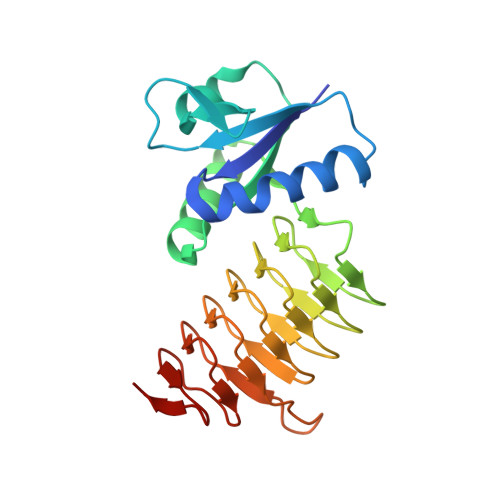Characterization of two enzymes from Psychrobacter cryohalolentis that are required for the biosynthesis of an unusual diacetamido-d-sugar.
Linehan, M.P., Thoden, J.B., Holden, H.M.(2021) J Biol Chem 296: 100463-100463
- PubMed: 33639157
- DOI: https://doi.org/10.1016/j.jbc.2021.100463
- Primary Citation of Related Structures:
7L7X, 7L7Y, 7L7Z, 7L81, 7L82 - PubMed Abstract:
Psychrobacter cryohalolentis strain K5 T is a Gram-negative organism first isolated in 2006. It has a complex O-antigen that contains, in addition to l-rhamnose and d-galactose, two diacetamido- and a triacetamido-sugar. The biochemical pathways for the production of these unusual sugars are presently unknown. Utilizing the published genome sequence of the organism, we hypothesized that the genes 0612, 0638, and 0637 encode for a 4,6-dehydratase, an aminotransferase, and an N-acetyltransferase, respectively, which would be required for the biosynthesis of one of the diacetamido-sugars, 2,4-diacetamido-2,4,6-trideoxy-d-glucose, starting from UDP-N-acetylglucosamine. Here we present functional and structural data on the proteins encoded by the 0638 and 0637 genes. The kinetic properties of these enzymes were investigated by a discontinuous HPLC assay. An X-ray crystallographic structure of 0638, determined in its external aldimine form to 1.3 Å resolution, demonstrated the manner in which the UDP ligand is positioned into the active site. It is strikingly different from that previously observed for PglE from Campylobacter jejuni, which functions on the same substrate. Four X-ray crystallographic structures were also determined for 0637 in various complexed states at resolutions between 1.3 and 1.55 Å. Remarkably, a tetrahedral intermediate mimicking the presumed transition state was trapped in one of the complexes. The data presented herein confirm the hypothesized functions of these enzymes and provide new insight into an unusual sugar biosynthetic pathway in Gram-negative bacteria. We also describe an efficient method for acetyl-CoA synthesis that allowed us to overcome its prohibitive cost for this analysis.
Organizational Affiliation:
Department of Biochemistry, University of Wisconsin, Madison, Wisconsin, USA.


















